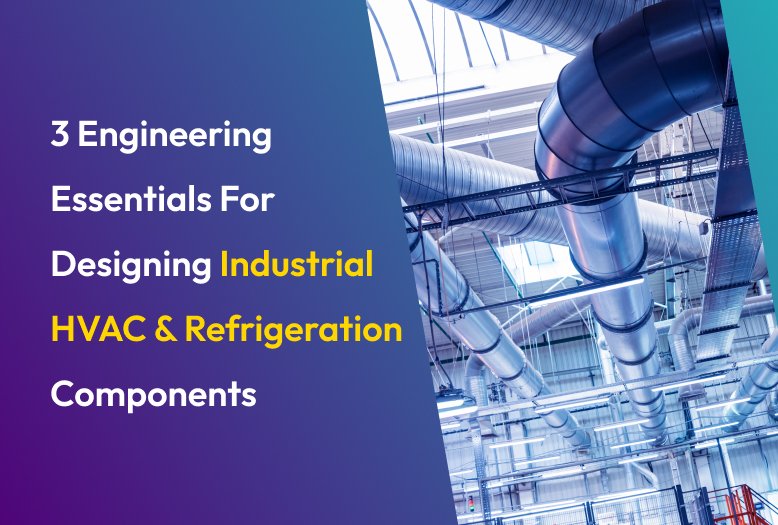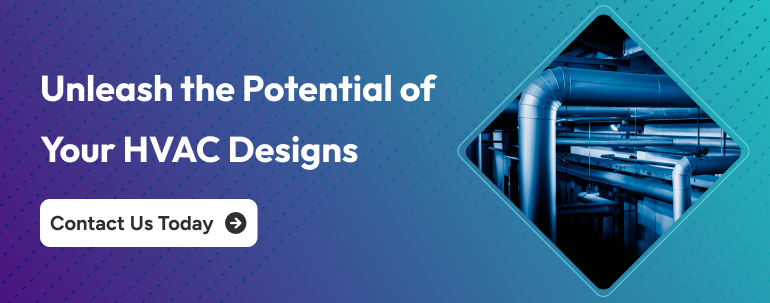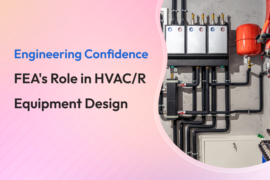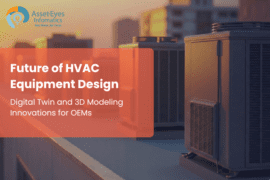Introduction About HVAC and Refrigeration
In the demanding world of industrial environments, HVAC and refrigeration systems form the backbone of countless operations across manufacturing, food processing, pharmaceuticals, and data centers. The components that make up these systems must perform reliably under challenging conditions while meeting increasingly stringent efficiency standards and regulatory requirements.
When designing industrial HVAC and refrigeration components, engineers must carefully balance performance, longevity, compliance, and cost-effectiveness. This balance is achieved through meticulous attention to three fundamental considerations: thermal efficiency, structural integrity, and material selection. These elements are not isolated factors but interconnected aspects that together determine the success or failure of a system.
Modern HVAC equipment design requires specialized expertise that combines engineering principles with practical application knowledge. As a leading machine design company, we’ve seen firsthand how these three considerations influence every aspect of component performance, from initial concept through manufacturing and installation.
This blog explores these three key considerations that should guide every industrial HVAC and refrigeration component design process, providing insights into how they impact performance and compliance in real-world applications.
1. Thermal Efficiency HVAC and Refrigeration
Thermal efficiency stands as perhaps the most critical factor in HVAC and refrigeration design. It directly impacts energy consumption, operational costs, and environmental footprint. A thermally efficient design minimizes energy waste, reduces the load on system components, and extends equipment lifespan.
Heat Transfer Optimization HVAC and Refrigeration
- Component geometry must maximize surface area for heat exchange while minimizing thermal bridging
- Heat exchanger designs require careful consideration of fin configuration, tube arrangements, and flow patterns
- Advanced computational fluid dynamics (CFD) simulations help model and enhance thermal dynamics before physical prototyping
Our CAD drawing services focus heavily on optimizing these geometries. Through detailed SolidWorks design processes, we can model heat exchange surfaces that maximize efficiency while ensuring manufacturability.
Airflow Management HVAC and Refrigeration
- Proper airflow distribution prevents dead zones and hot spots that compromise system efficiency
- Pressure-drop calculations ensure adequate air movement without excessive fan energy consumption
- Duct and plenum design must balance space constraints with optimal flow characteristics
Industrial ventilation system design presents unique challenges that require specialized expertise. The complex nature of industrial airflow patterns means that both macro and micro design elements must work in harmony.
Insulation Strategy
- Strategic insulation placement prevents thermal leakage while avoiding condensation issues
- Material selection must consider R-value, moisture resistance, and long-term performance
- Thermal bridges must be identified and addressed to prevent efficiency losses
Key Takeaways: Thermal Efficiency HVAC and Refrigeration
- Start with theoretical thermodynamic modeling to establish performance targets before detailed design
- Optimize component geometry for maximum heat transfer while minimizing pressure drops
- Use advanced simulation tools to validate designs before physical prototyping
- Consider the entire thermal system, not just individual components
- Balance compact design requirements with thermal performance needs
2.Structural Integrity HVAC and Refrigeration
Industrial HVAC and refrigeration systems face numerous physical challenges including vibration, thermal expansion/contraction cycles, pressure fluctuations, and environmental stressors. Component design must account for all these factors to ensure long-term reliability.
Load Analysis
- Components must withstand static loads (weight, pressure), dynamic loads (vibrations), and thermal loads (expansion/contraction)
- Support structures require proper sizing to prevent deflection that could impact system performance
- Connection points often represent critical failure areas requiring reinforcement
Creating a comprehensive general assembly drawing early in the design process helps identify potential structural issues before they become costly problems.
Vibration Management
- Vibration isolation systems prevent transmission of mechanical energy that can cause component fatigue
- Resonance frequency analysis identifies potential harmonic issues before deployment
- Mounting systems should allow components to expand and contract safely without causing damage or performance loss
Thermal Expansion Accommodation
- Materials expand and contract at different rates with temperature changes
- Expansion joints and flexible connections prevent stress buildup during thermal cycling
- Component mounting must allow for controlled movement without compromising system alignment
Failure Mode Anticipation (Structural FEA Readiness):
Common Challenges: Load stresses, vibrations, and transport shocks can silently weaken HVAC/R systems, leading to field failures and warranty costs.
How Asset-Eyes Helps:
- We build models designed for structural simulation (FEA), ensuring clients can validate mechanical robustness early
- Our approach predicts how components will respond to mechanical loads and vibration
- We identify high-stress areas that may experience premature fatigue
- We simulate extreme conditions that would be difficult to test physically
Key Takeaways: Structural Integrity
- Address vibration and thermal cycling from the earliest design stages
- Identify potential failure points through simulation before physical testing
- Pay special attention to connection points and material interfaces
- Design for the full range of operating conditions, not just typical scenarios
- Remember that structural integrity directly impacts both safety and long-term reliability
3.Material Selection
The choice of materials dramatically impacts system performance, longevity, compliance, and cost. Engineers must carefully evaluate options based on multiple competing factors to select the optimal materials for each component.
Corrosion Resistance
- Industrial environments expose components to moisture, chemicals, and temperature fluctuations
- Material selection must consider both galvanic and environmental corrosion factors
- Protective coatings and finishes can extend component life in harsh environments
- Regular maintenance requirements should influence material choices
This consideration becomes particularly important in electrical control panel design, where moisture and condensation can compromise system safety and reliability. Material choices must account for both the operating environment and potential emergency conditions.
Temperature Compatibility
- Materials must maintain their mechanical properties across the full operating temperature range
- Extreme temperature applications require specialized materials that resist embrittlement or softening
- Thermal expansion coefficients must be considered, especially at material interfaces
Evaporative cooling system design presents unique material challenges due to constant water exposure combined with temperature fluctuations. Our material selection process accounts for these specific operating conditions to ensure long-term reliability.
Mechanical Properties
- Strength-to-weight ratio affects both performance and installation requirements
- Fatigue resistance becomes critical in components subject to cyclic loading
- Impact resistance may be necessary for components exposed to potential physical damage
The design of motor control panels, for example, requires particular attention to material selection, as these components must withstand both electrical and mechanical stresses while providing adequate protection for sensitive control equipment.
Regulatory Compliance
- Materials must meet industry-specific regulations regarding fire resistance, off-gassing, and environmental impact
- Low Global Warming Potential (GWP) refrigerants require compatible materials
- Food-grade applications have specific material requirements for safety
Key Takeaways: Material Selection
- Evaluate materials based on lifecycle costs, not just initial purchase price
- Match material properties to the specific operating environment and conditions
- Consider maintenance requirements when selecting materials
- Remember that material choices affect both thermal performance and structural integrity
- Stay informed about evolving regulations that may impact material requirements
Conclusion
Designing industrial HVAC and refrigeration components requires a holistic approach that carefully balances thermal efficiency, structural integrity, and material selection. These three key considerations are deeply interconnected—a change in material affects both thermal performance and structural integrity; structural design impacts thermal efficiency; thermal requirements influence both material selection and structural needs.
The most successful designs emerge when engineers address these considerations from the earliest concept stages rather than treating them as separate checklist items. By taking this integrated approach, designers can create components that deliver optimal performance while ensuring compliance with industry standards and minimizing lifecycle costs.
As industrial environments continue to evolve with demands for greater efficiency, smaller footprints, and stricter regulations, the expertise to navigate these complex design considerations becomes increasingly valuable. At Asset-Eyes, we integrate these considerations into every stage of our design process, ensuring that our clients receive HVAC and refrigeration components that not only meet current requirements but are positioned to adapt to future challenges.
By also focusing on these three key considerations and their interactions, engineers can create industrial HVAC and refrigeration components that deliver exceptional performance, reliability, and value throughout their operational life.
Get Expert Support for Your HVAC/R Projects
Partnering with us for your HVAC/R equipment design and drafting needs means gaining a precision-focused ally committed to your success. We also invite you to reach out to discuss your specific requirements and learn how our expertise can benefit your next project. Our team of experienced engineers can help you optimize designs, troubleshoot existing equipment issues, and validate performance under a wide range of operating conditions.
Contact Us Today:
📞 +91 9840895134








